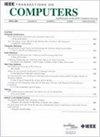NetCRC-NR: In-Network 5G NR CRC Accelerator
IF 3.6
2区 计算机科学
Q2 COMPUTER SCIENCE, HARDWARE & ARCHITECTURE
引用次数: 0
Abstract
In 5G Radio Access Networks (RAN), Cyclic Redundancy Check (CRC) algorithms play a vital role in detecting accidental changes to digital data during transmission. However, due to the massive bandwidth demands in 5G networks, CRC computation is a resource-intensive process. To address this challenge, we propose performing CRC computation and verification directly in the network path. Specifically, we introduce NetCRC-NR, a 5G New Radio (NR) standard-compliant in-network CRC accelerator. NetCRC-NR implements the 5G NR CRC algorithms specified in 3GPP TS 38.212, including CRC24A, CRC24B, CRC24C, CRC16, CRC11, and CRC6. It leverages programmable switches to perform in-network CRC generation and validation for the Transport Blocks (TBs) and Code Blocks (CBs), aiming at providing high CRC computation throughput and alleviating the computational burden on General-Purpose Processors (GPPs). We design and implement NetCRC-NR on Intel Tofino programmable switch and commodity servers running the Data Plane Development Kit (DPDK). Extensive experiments demonstrate that NetCRC-NR performs CRC generation and verification at the switch line rate of up to 4+Tbps CRC throughput, showcasing its efficiency and potential in accelerating the 5G RAN error detection process.求助全文
约1分钟内获得全文
求助全文
来源期刊

IEEE Transactions on Computers
工程技术-工程:电子与电气
CiteScore
6.60
自引率
5.40%
发文量
199
审稿时长
6.0 months
期刊介绍:
The IEEE Transactions on Computers is a monthly publication with a wide distribution to researchers, developers, technical managers, and educators in the computer field. It publishes papers on research in areas of current interest to the readers. These areas include, but are not limited to, the following: a) computer organizations and architectures; b) operating systems, software systems, and communication protocols; c) real-time systems and embedded systems; d) digital devices, computer components, and interconnection networks; e) specification, design, prototyping, and testing methods and tools; f) performance, fault tolerance, reliability, security, and testability; g) case studies and experimental and theoretical evaluations; and h) new and important applications and trends.
 求助内容:
求助内容: 应助结果提醒方式:
应助结果提醒方式:


